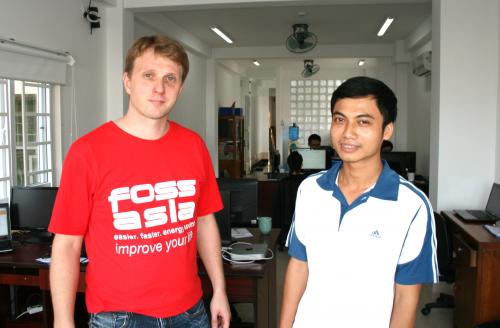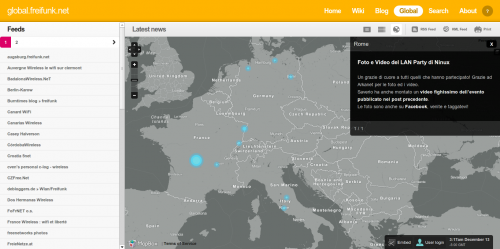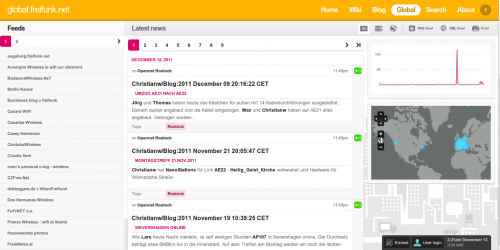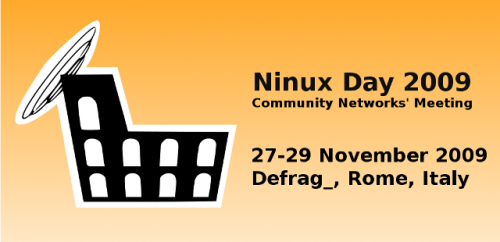


Das Community Blog




Angelo Serpa kommt aus Brasilien und ist Professor an der Bundesuniversität Bahias (Universidade Federal da Bahia). Zur Zeit ist er Gastwissenschaftler (Post-Doktorand) im Geographischen Institut an der Berliner Humboldt-Universität.
J: Herr Serpa, Sie beschäftigen sich bereits seit einigen Jahren wissenschaftlich mit Kommunikationsmedien, die von einer lokalen Community selbst verwaltet und betrieben werden. Was ist das besondere an diesem Prinzip und welche Projekte haben Sie bereits untersucht?
AS: Wir haben im Jahr 2005 in Salvador da Bahia, Brasilien, diese Forschung über lokalbezogene Medieninitiativen angefangen. Salvador ist eine 3 Millionen Einwohner Metropole, wo es grosse soziale Unterschiede gibt, die in der Stadtlandschaft sehr ausgeprägt sind. Einerseits gibt es einige reiche Viertel, die sehr gut mit Infrastruktur versorgt sind, andererseits Viertel, die „arm“ sind, wo keine gute Infrastruktur vorhanden ist. Es herrscht Stadtsegregation und gibt viele Vorurteile gegen die „armen“ Viertel: sie seien gefährlich, dort gäbe es nichts ausser Kriminalität und Drogenhandel. Aber gerade in diesen Vierteln leben viele Künstler, die zum Beispiel den Karneval von Salvador, das grösste Strassenfest Brasiliens, mit ihrer Kunst, mit ihrem Tanz, ihrer Musik sozusagen „ernähren“. Ich spreche hier von Leuten, die die Armut zum künstlerischen Reichtum im Alltag umwandeln. Es sind diese Leute, die in diesen Vierteln „Community Radios“ machen, Radios, die nicht kommerziell sind und keine öffentliche Unterstützung bekommen. Meistens hört man diese Radios einfach direkt per Lautsprecher auf der Strasse, obwohl einige von ihnen auch richtig über eine eigene Frequenz senden.
Andere Initiativen beschäftigen sich mit der Herstellung von Inhalten für Homepages, die die Vorurteile gegen ihre Viertel abbauen wollen. Das besondere an solchen Initiativen ist die Tatsache, dass sie überhaupt existieren, in einem Kontext, wo der Zugang zur Technik, zur Technologie, derart begrenzt ist, dass es im Alltag schon eine Menge Kreativität und Mühe von diesen Leuten abverlangt.
J: Welche Möglichkeiten sehen Sie im Umgang mit diesen Do-It-Yourself betriebenen Medien für die Menschen, die sie betreiben und die jeweilige lokale Community?
AS: Das ist eben die Möglichkeit, Inhalte für Radios und Internet selbst herzustellen. Inhalte und Programme, die mehr mit dem Alltag dieser Viertel, diesen Bezirken zu tun haben. Das kann auch mehr Autonomie für diese Gruppen und Initiativen bedeuten, indem sie sich die Medien auf lokaler Ebene aktiv aneignen und die Inhalte von Radiosendungen und Homepages selbst bestimmen. Natürlich hängt der Erfolg solcher Initiativen sehr stark von den vorhandenen technischen Kentnissen und Möglichkeiten ab. Eigentlich lernen diese Leute den Umgang mit der Technologie in ihrem Alltag, indem sie nämlich selbst die alltäglichen Problemen damit und mit dem generellen Mangel an Infrastruktur in diesen Vierteln und Bezirken zu lösen versuchen. Gleichzeitig wird durch solche Initiativen auch versucht, die Isoliertheit dieser Viertel zu durchbrechen. Diese Do-it-yourself-Medieninitiativen und -gruppen sind in Brasilien für viele Menschen ein Fenster zur Welt.
J: Hier in Deutschland interessieren Sie sich gerade auch für freifunk.net. Was ist aus Ihrer Sicht das besondere an diesem drahtlosen Community-Netzwerk "Made in Germany"?
AS: Ich sehe freifunk.net als eine politische Medieninitiative, obwohl es sehr viel mit Technik zu tun hat. Ein dezentralisiertes Netz, das von den Nutzern selbst betrieben wird, das ist ohne Zweifel sehr geeignet, um die Medienkompetenz der Teilnehmer zu erhöhen. Andererseits verlangt Freifunk von den Teilnehmern in Kontakt mit ihrer Umgebung, mit den Nachbarn zu treten, was heutzutage fast „subversiv“ klingt. Das heisst, in diesem Kontext fördert die Technik, die Technologie, die Begegnung, das Treffen von Menschen, um etwas Kollektives auf die Beine zu stellen. In Berlin, scheint das Freifunk-Netz in einigen Bezirken wie Friedrichshain sehr gut zu funktionieren. Die Herausforderung ist, in anderen Bezirken, wo DSL bereits sehr verbreitet ist, das Freifunk-Netz zu etablieren.
J: Sie möchten gerne auch in Brasilien in den ärmeren Stadtvierteln freifunk-Initiativen starten. Welche Chancen sehen Sie darin? Warum ist gerade freifunk.net aus Ihrer Sicht dafür so geeignet?
AS: Aus meiner Sicht muss man in solchen Vierteln zunächst von den Kenntnissen der Einwohner ausgehen. In diesem Fall müsste man also Partnerschaften in den Vierteln suchen und versuchen mit den Leuten vor Ort zusammen zu arbeiten, die irgendwie fähig dazu sind, andere Einwohner zu mobilisieren und sich an dem Projekt zu beteiligen. Gleichzeitig muss man sich auch Gedanken machen, wie mehr Zugang zum Netz geschaffen werden kann, vor allem dort, wo es sehr wenige Computer gibt. Vielleicht sollte man zusammen mit den Internet Cafes, die in diesen Vierteln schon vorhanden sind, arbeiten, aber gleichzeitig auch neue Computer kaufen und in bestimmten Teilen des Viertels verteilen. Oder, nach einer Idee von Frieder Bronner, von Openmedia hier aus Berlin, eine eigene Computerfabrik aufbauen, damit die Einwohner des Viertels selbst die Computer zussamensetzen. Das wäre vielleicht sinnvoller als alte Computer wieder aufzubereiten – vielleicht auch billiger. In jedem Fall könnte sich dadurch die Situation für die Menschen im Viertel in einigen Bereichen sehr verbessern.
J: Sie kommen aus Brasilien und leben aber gerade für einige Zeit in Berlin. Was denken Sie darüber, dass die Stadt Berlin schon seit einiger Zeit versucht, das Thema "Offenes WLAN für Berlin" an einen kommerziellen Provider abzugeben und dabei die Idee von freifunk.net als lokale Initiative und vor allem als "Kooperatives Modell" bisher völlig ingnoriert wurde?
AS: Ich finde das schade. Es ist schade, dass all die Erfahrungen, die die Leute hier mit Freifunk in den letzten Jahren gemacht haben, nicht von der Stadt Berlin berücksichtigt werden. Aber es ist auch verständlich, dass so etwas wie ein dezentralisiertes Netz, ein nichtkommerzielles Netz, ohne Hierarchie, mit einiger Skepsis von Seiten der Stadtregierung angesehen wird. Das ist überall so, auch in Salvador und anderen Städten Brasiliens. Solche Sachen machen den Stadtregierungen Angst, vielleicht weil solche Initiativen nur schwer unter „soziale Kontrolle“ zu bringen sind. Es ist schade, weil gerade eine Initiative wie Freifunk die Medienkompetenz der Teilnehmer erhöhen könnte und mehr Autonomie in der Stadt schaffen würde.
J: Halten Sie freifunk.net für einen geeigneten Weg, um in einer Art Public-Private-Partnership das Netzwerk auch in die strukturschwacheren Gegenden der Stadt zu bringen, wo es eigentlich am dringensten gebraucht würde?
AS: Sicher, aber hier müsste man die Stadtregierung davon überzeugen, dass ein nicht hierarchisches Netz, in dem die Leute selbst die Funktionsweise des Netzes bestimmen und auch selbst dafür verantwortlich sind, welche Inhalte und Erfahrungen sie darüber austauschen wollen, ein geeigneter Weg zur Erhohung der Medienkompetenz ist. Andererseits ist es meiner Meinung nach sehr schwierig, dass eine solche Idee ein positives Echo unter den Politikern findet. Ich frage mich auch, ob es wirklich der beste Weg wäre, mit Stadtregierungen zusammen zu arbeiten. Vielleicht gibt es auch andere Wege, ein solches Netz aufzubauen, zum Beispiel NGOs als Partner zu haben.
J: Herr Serpa, Ich danke Ihnen für dieses sehr interessante Gespräch.

The Ninux.org team announced the first “Ninux Day”, a weekend with about and for wireless communities. You will meet software and hardware hackers, geeks, nerds, engineers, artists, the curious and
academics. Experts from all over Europe offer technical and social presentations in the area of wireless community networks.
Join the Ninux Days in Rome, Italy, from November 27-29, 2009.

More Info here:
* http://wiki.ninux.org/NinuxDay2009
* http://wiki.ninux.org/NinuxDay2009en (English)
* http://wiki.ninux.org/NinuxDay2009it (Italian)
* Announcement: http://blog.ninux.org/2009/09/03/ninux-day-2009
* Ninux Blog http://blog.ninux.org
[via ZioPRoTo]
Bristol Wireless is a community project where people formed a cooperative to work together. They provide services all over Bristol, UK. I found a video that was produced already in 2005 now. Enjoy!
Links:
* http://www.bristolwireless.net
* YouTube http://www.youtube.com/watch?v=ZlB92EJgwIY
* Download: http://www.bristolwireless.net/video/bw_90_sec_challenge.mp4
Eight Questions to answer for your application for the Freifunk Summer of Code. We are interested in your
answers to get an idea, how you would be able to contribute to
Freifunk. Dont worry too much about a correct English. We are more
interested in the content of what you have to say and how you could
join up with us, than about perfect Englich.
1. Please tell us your name and your country or origin or local background.
2. Please list contributions to the Freifunk/OpenWrt and related
projects or any other freely licensed Open Source project below.
3. Please tell us about your proposed project and the relevance to
Freifunk. You can also provide a link where you offer more details here.
4. What is your expertise and ability to conduct the project you
propose? How do you plan to achieve the goals of the proposed project?
5. How would you describe your knowledge of development of Linux OS and OpenWrt related programming languages such as Lua?
6. How do you think you will participate in the Freifunk/OpenWrt development after the Google Summer of Code?
7. What would you like us to do to ensure that you stick with the project after the program concludes?
8. How do you plan to keep in touch with the Freifunk/OpenWrt community and your mentor during the summer of code?
Links
* http://socghop.appspot.com/org/show/google/gsoc2009/ffopenwrt
* Ideas http://wiki.freifunk.net/Ideas

 It seems to me sometimes some people think of Freifunk as a software and network project only. For me Freifunk is an idea and philosophy in the first place. Freifunk means the freedom to connect in local and global networks. It is the equivalent to free and open source software as for Gnu/Linux or free content as for Wikimedia. What Freifunk means to me and implies as policies:
It seems to me sometimes some people think of Freifunk as a software and network project only. For me Freifunk is an idea and philosophy in the first place. Freifunk means the freedom to connect in local and global networks. It is the equivalent to free and open source software as for Gnu/Linux or free content as for Wikimedia. What Freifunk means to me and implies as policies:
Xavier Carcelle has put some videos online from the Open Tech Summit in Taiwan at the beginning of 2008. Juergen Neumann of the Freifunk Community talks about the beginnings and history of open Wi-Fi.
Google Video: http://video.google.com/videoplay?docid=4426529986868760558

The OpenWrt team (Cph) has announced a new version of its Linux distribution for embedded wireless devices named "OpenWrt Kamikaze 808 Release". I talked to Felix Fietkau already at the WCW. Unfortunately we did not have the time to do an interview at the end. But Cyrus from freifunk Halle gave a short showcase of his interface (in German). The OpenWrt team was also impressed by it and they now announce the enclosure of the Luci interface officially. Congratulations Cyrus!

It has been quite a while since OpenWrt had a new Kamikaze release. The developer team has decided that it is time to get things straight and focus on a new release. This release have the official name: OpenWrt Kamikaze 808 Release.
The schedule will look like this:
*Last day in July – final release candidate: 808 RC-1 808 RC-1 will be a feature freeze, and all changes after this point will be bug fixes.
*Last day in August – final release: OpenWrt Kamikaze 808 Release.OpenWrt Kamikaze 808 Release will focus on bringing the following:
– Firewall rewrite
– Broadcom 47xx running reliably with the new Kernel, not including wifi
– IMQ and Traffic shaping tested with newer kernels, especially 2.6.25
– Sysupgrade for more platforms (x86 is tested again)
– The new web interface (LuCI, Lua Configuration Interface)
– Attention towards the integration of security updates
– Package maintaining and updates between releases
– Testing, testing and lots of testing…The 808 Release will also include support for several new platforms/targets. (http://forum.openwrt.org/viewtopic.php?pid=69873 )

The Journal "Community informatics" has published a special about Wireless Networking for Communities, Citizens and the Public Interest. Authors include Michael Gurstein, Alison Powell, Sascha D. Meinrath, Marco Adria, Hanna Hye-Na Cho, Laura Forlano, Andrea H Tapia, Julio Angel Ortiz, Kim Dara, Seán Ó Siochrú, Vidyut Samanta, Chase Laurelle Alexandria Knowles, Jeff Burke, Fabian Wagmister, Deborah Estrin, Ermanno Pietrosemoli, Andrew Clement, Amelia Potter, Alisha Bhagat.

This special issue documents the state of the art in
research on community wireless applications, and presents assessments
of community wireless projects in a variety of local contexts: from
large urban centers in North America to rural locations in Asia and
Latin America. Together, the papers and field notes in this special
issue reflect on a community-centric approach to communications
infrastructure development. These works describe the challenges – both
practical and theoretical – that face community wireless networking, as
well as the implications many of these projects have to support social
and economic justice around the globe.The papers in this special issue demonstrate that
community-based approaches to Wifi development are part of a broader
integration of technology, organizational capacity, and local culture.
Social goals are part of most community Wifi projects, and integrating
these goals and the technical structures of Wifi networks is part of
what makes many community Wifi projects successful. Both full papers
and field notes explore this integration and focus on various facets of
the community wireless networking movement.The papers included in this issue explore different
theoretical approaches that help situate community wireless networking
as social and technical phenomena. Adria provides a meta-theoretical
discussion of how Wifi networks reconfigure space and time — using the
medium theory of McLuhan and Virilio to suggest that Wifi networks have
the potential to integrate local geographical and temporal experiences.The other papers use empirical approaches to assess the
social aspects of community wireless networking. Tapia and Ortiz
explore the claims made by operators of municipal-community networks
that these projects are addressing the digital divide. Using a textual
analysis of claims made in documents including “press releases,
requests for proposals, letters of intent, and other official policy
documents,” as well as interviews with key informants in US
municipal-community projects, they interrogate the extent to which
networks facilitate meaningful digital inclusion.Both Cho and Forlano explore the social aspects of
community wireless networking in more detail: Cho focusing on the
development of networks and Forlano on their use. Cho reveals how the
development of community wireless networks (CWNs) builds social capital
for the participants. She develops the concept of “place-peer
community” to explain how Wifi projects define “community.” Cho also
describes how contributions to community wireless networks help to
develop ‘civic bandwidth’ among their contributors. Like Tapia and
Oritz, she identifies CWNs as developing a discourse that connects the
development of digital information and communication technologies with
efforts to improve communities.Forlano explores the new social relationships created
through the everyday use of community-based Wifi networks, examining
the gap between media representations of Wifi as an “anytime, anywhere”
solution and the socio-cultural practices of people using free Wifi
hotspots in New York City. As she discovers, freelance workers use Wifi
hotspots to create temporary working environments that eliminate some
of the isolation of working without a fixed office, while providing a
basic infrastructure including network connectivity and electrical
power. These Wifi hotspots support communities of mobile, flexible
workers who establish relationships with a particular place and its
people. Together with Cho’s insights about the social capital mobilized
through the process of developing community Wifi networks, this
suggests that Wifi hotspots may have a unique role to play in
redefining the experiences of community in urban areas.The field notes in this issue offer a window into the
realities of local experiments with Wifi technology. The impacts of the
projects they document depend on the local political context (Clement),
the community’s capacity (Dara, Dimanche, and O Siochru; Bhagat), the
potential for community and industry partnerships to create new ways
for community members to gather data and to aggregate it (Samanta), and
how changing our assumptions about the role of wireless infrastructure
can open up new opportunities for affordable broadband (Pietrosemoli).These notes highlight how local contexts influence what
is considered the “public interest” and how community wireless projects
can best serve the general public. For example, Clement criticizes the
Toronto Hydro Wireless project, considered a technical success, because
its governance structure forces the network to be operated for-profit
rather than as a public service. Samanta provides an outline of some
potential social uses for an experimental wireless network that could
aggregate data from numerous wireless devices. Some suggested uses of
this network include collecting ambient audio data that, when mapped,
could provide quality of life indicators.In the global South, the public interest is served by the
communication and applications made possible by wireless networks
established in previously un-served areas. In these contexts as well,
important challenges also emerge. Bhagat assesses the results of a mesh
network built in Mahavilachchiya village where a local entrepreneur
developed a wireless network as an extension of a computer school where
local children learned ICT skills. This Wifi connectivity project
extended internet access to homes, and encouraged more local residents
to use the internet. However, Bhagat also notes that connecting the
village to the internet may have negative impacts as well: introducing
new forms of media and new social expectations to the village and
disrupting historical cultural norms.Dara, Dimanche and O Siochru explore how local political
and social contexts impact the design and deployment phase of one local
wireless network. From the challenging context of Cambodia, they report
on the first phase of the I-REACH project, a distributed mesh network
providing internet connectivity and local media using solar-powered
devices. The project’s challenges in obtaining permission from local
government, sourcing material, and recruiting qualified local staff and
contractors underscores the notion that community-based infrastructure
implementation is a social (and an institutional) as well as a
technical endeavor.Ermanno Pietrosemoli and his international team of Wifi
researchers have deployed wireless links spanning hundreds of
kilometers. By proofing out a methodology for creating low-cost,
long-distance Wifi, Pietrosemoli forces us to question the notion that
Wifi is just for local networking. As a potential backhaul solution,
Wifi may offer an exceptional value for communities and constituencies
that would not otherwise be able to afford broadband connectivity.Across these paper and notes, a common thread linking the
articles is the importance of establishing local strategies for
leveraging wireless technologies in the public interest. (Alison Powell, Sascha D. Meinrath, Introduction to the Special Issue: Wireless Networking for Communities, Citizens and the Public Interest, Vol. 4 No. 1, 2008, http://ci-journal.net/index.php/ciej/article/view/490/389)
Saverio from the Italian Ninux community has now published a video interview Daniel Paufler and I conducted with them at the Wireless Community Weekend in Berlin. Thank you very much for the great montaggio! It is real fun to watch!
Interview to Ninux and Freifunk members at WCW2008 from Saverio Proto on Vimeo.
Direct Link: http://www.vimeo.com/1052320
In Berlin, at C-Base, people from wireless communities all around
Europe meet to share ideas and experiences. See this interview by Mario
Behling with free networks activists from Ninux.org and Freifunk.net